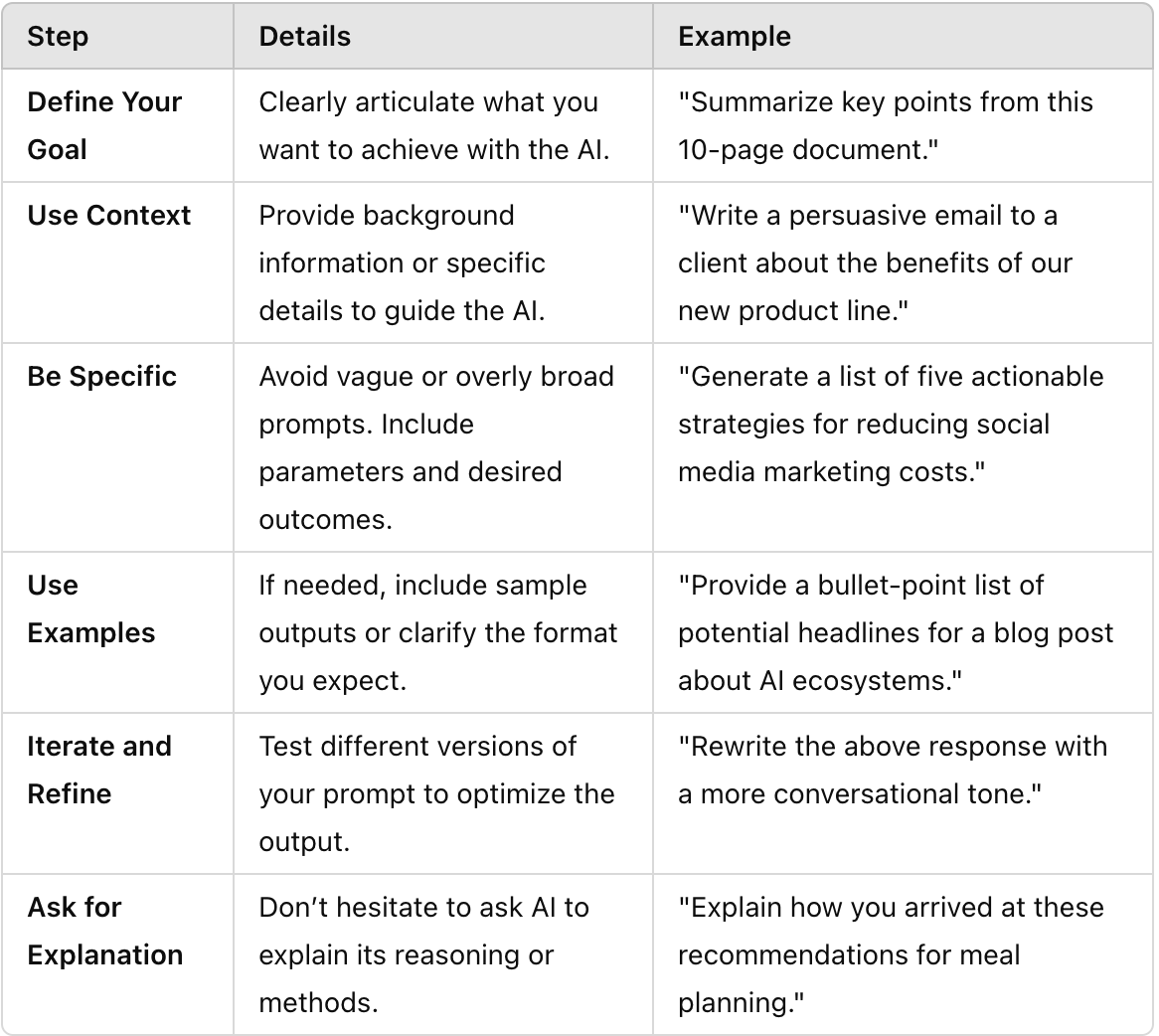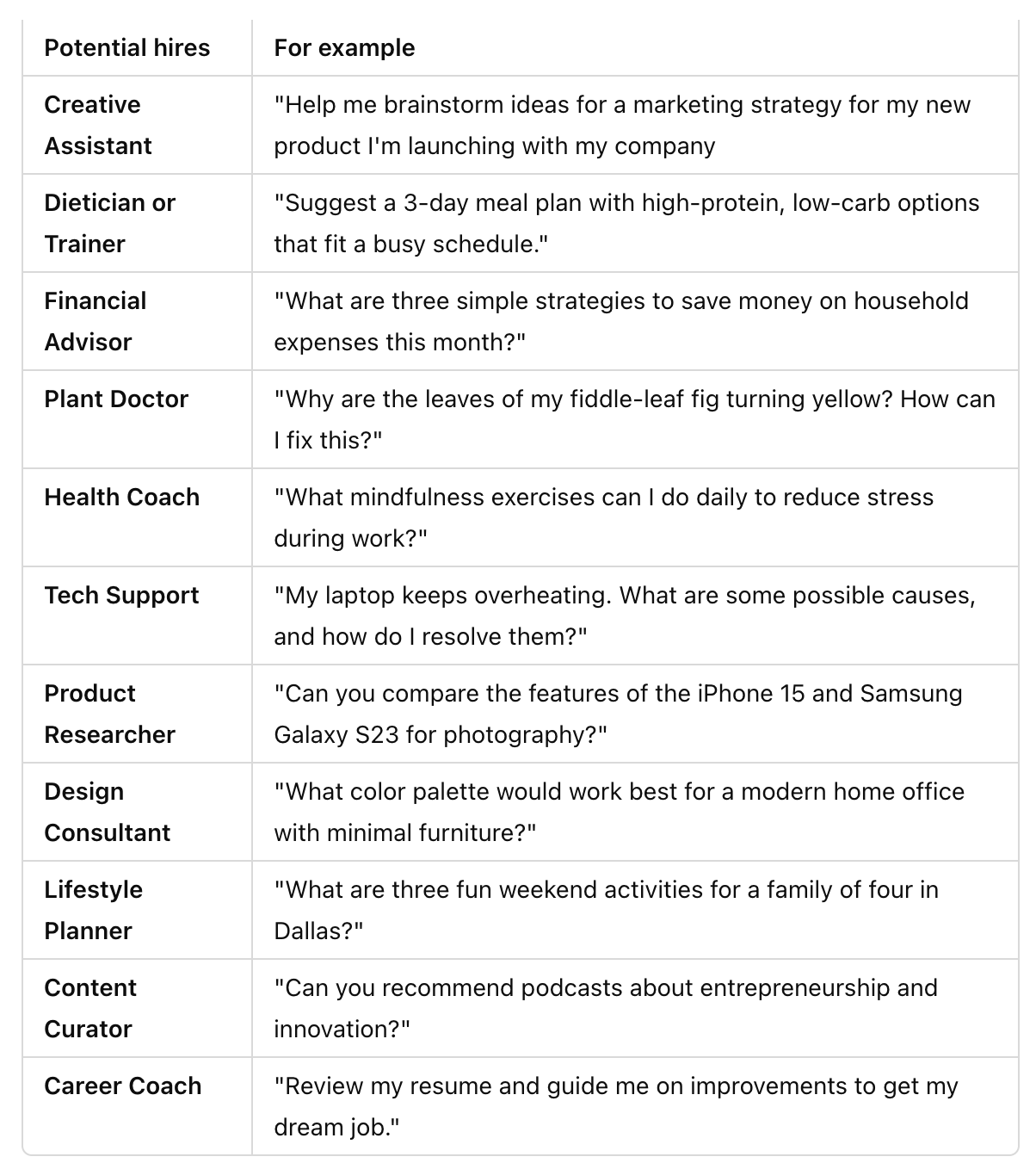How to design your AI Ecosystem
Fundamental AI tools and how to start leveraging it in your everyday life.
If you’re anything like me, you’re wondering about one of three things regarding AI: Is it worth the hype? Is it going to replace all of our jobs? Are we all doomed?
In short, yes. Kind of, and maybe.
However, those answers depend entirely on each person’s knowledge and comfort with the rapidly emerging tools and features flooding into our everyday lives.
To say that things are progressing beyond my comprehension is a hilarious understatement. So, I'll spare myself the embarrassment of digging into the intricate details of AI; more qualified individuals and resources exist for that.
Nonetheless, today's newsletter is my best shot at removing some of the magic surrounding the AI discussions and presenting practical ways you can start to design your own AI ecosystem.
But first a question 🤔…
🏁 First, the basics…WTF is AI?
Artificial intelligence, AI for short, refers to machines, computers and softeardthat are programmed to “think” and “learn” in ways similar to humans. These systems are designed to process information, recognize patterns, solve problems, and make decisions without explicit human instruction.
There are 3 different levels of Artificial intelligence.
Narrow AI makes decisions based on programmed rules and patterns in its training data. It lacks true understanding or reasoning.
General AI would have human-like reasoning abilities and be able to make decisions in novel situations.
Super AI could make decisions and solve problems far beyond human cognitive abilities.
As crazy as progress has been over the past few years, we’re still in narrow AI Land, and when or if the next two AI levels are achievable is currently up for debate.
For example, let's look at ChatGPT (The large language model created by OpenAI). Although it can hold a conversation and mimic a human voice surprisingly accurately, it is simply a program that tries to predict the right things to “say” based on what you say first. There is no magic beyond that.
That sounds simple enough, but it’s a giant leap compared to most of our early experiences with AI, such as Google Assistant, Alexa, and Siri. Outside of basic functions like telling you the weather, setting a reminder, and turning off a smart bulb, there was a narrow river of capabilities that you could leverage in your everyday life.
Today, that narrow creek of possibilities has opened into a roaring river. So, if we hope to navigate the rough open seas of AI ahead, we’ll have to get familiar with a few things.
🧰 Some foundational tools to start with…
Here’s a list of tools you may or may not have heard of, along with how I’m currently using them or plan to use them.
ChatGPT
I’ve used this the longest and most often, but I didn’t pay for the premium until just a couple of months ago, and it’s been worth every penny. It feels stiff at first, but the more you use it, the better it gets, especially once you give it the right prompts and instructions. This video is a cheat code that helped me get much more out of it.
Another benefit of the paid route is access to other variants of ChatGPT, which are tailored for unique use cases. So, once you've mastered the basics, start exploring the market!
Claude
I haven't used this much, but the features that will manifest due to the competition between OpenAI and Anthropic are worth exploring. They will strive to enhance their speed, efficiency, and capabilities by any means necessary so we, as consumers, will have an advantage.
This video analyzes some specific use cases that Claude excels at over ChatGPT. But I’ll have to report back once I use this more.
Perplexity
Goodbye, Google search. That was my first thought when I searched for something on Perplexity for the first time.
Not only does it provide a super clean summary or whatever you ask for, but it lays out all of its sources instead of annoying ads or meaningless jargon, so you can quickly jump further down the rabbit hole.
Think of this as more of a librarian compared to ChatGPT, which is more like a creative assistant. — Here’s a better explanation of features, strengths & weaknesses. 😅
Arc Browser
I've used every browser you can think of—Chrome, Firefox, Brave, whatever else you can name—and I wouldn't call any of those experiences intuitive, beautiful, or excellent. But Arc brings a new design approach to web browsing that accomplishes all of the above and has been a wonderful breath of fresh air.
The mobile experience is perfect for searching and browsing since it’s automatically integrated with Perplexity as its search engine.
Midjourney
As a person who can’t draw, the things you can do with this are mind-blowing. Like every other AI tool, If you want specific results, you’ll need a distinct prompt, but with a strict visual tool, it’s even more tricky. — Don’t worry; here are some tips to help you.
The biggest bummer is that it’s no longer free, but this is only needed if you have significant visual needs.
While I could add WAY more tools to an exhaustive list, consider these among the most advanced and versatile options for beginning your journey.
As you get more comfortable, look to discover more apps and features and share your favorites. 😎
Six Principles for Building Your AI Ecosystem
Now, it’s time to be tactical. For the sake of conversation, let’s define an “AI Ecosystem” as a thoughtful workflow that uses AI tools tailored to your specific needs and goals.
It’s essential to remember that success isn’t contingent on the tools; it’s about weaving them into the fabric of your life. Whether you want to supercharge your productivity, reclaim precious hours, or streamline decision-making, an intentional approach to incorporating AI will go a long way as technology advances.
So here are six key principles to help you build a thriving AI ecosystem.
1. Identify Your Needs and Goals
Knowing what you're solving for or the outcome you want to drive is the first step to building your ecosystem. AI is like a hammer: it’s only useful if you know what you’re building.
Assess Your Routine: Write down tasks that drain your time and energy. Look for bottlenecks, inefficiencies, or activities that could be automated.
Set Clear Objectives: Are you chasing more free time? Sharper insights? Career growth? AI can help you set goals, map action plans, and refine your vision. Be specific. Instead of saying, “I want to be more productive,” aim for, “I want to free up three hours a week by automating repetitive tasks.”
Your goals will determine the tools you’ll need and how AI can fit best into your workflow.
2. Write Better Prompts
AI thrives on clarity, so ultimately, your output is only as good as your input.
Start Simple: Not sure where to begin? Treat your prompt like a conversation. Instead of asking, “Tell me about AI,” try, “What are three practical ways I can use AI to save time on email management?”
Iterate: Experiment with phrasing and specificity. AI is dynamic, so you can refine your prompts until you reach the sweet spot of actionable insights.
Another cheat code I like to use is ending every question with “Ask me any questions needed to clarify the task or improve the results.” This allows you to quickly refine the results to be more tailored to your needs.
3. Leverage Compatibility
Your ecosystem doesn’t have to start from scratch. Chances are, you’re already using apps with AI capabilities baked in—you just haven’t used them yet.
Audit Your Stack: Inventory the apps, software, and platforms you rely on. Many Google tools, productivity apps, and streaming apps now have AI features.
Connect the Dots: Look for opportunities to integrate. For example, use AI within your calendar app to suggest meeting times or leverage AI writing tools built into your document editor. Google Docs is an easy place to start.
4. Hire an expert
The most exciting part of leveraging AI is the chance to have a personal team in your pocket. If you have a question about anything and everything, you can ask AI and get some guidance. — Below is a list of things to inspire you.
Hiring an expert doesn’t just save time. It creates mental bandwidth to take action instead of spending it on research.
5. Learn and Adapt
The AI landscape is evolving as we speak. To keep your ecosystem thriving, you’ll need to stay nimble.
Stay Updated: Follow blogs, podcasts, and newsletters that cover AI trends. Knowledge is power, and staying informed means you’ll always be a step ahead.
Trial and Error: Not every AI tool will fit your needs, and that’s okay. Test new programs and refine your ecosystem based on what works best.
Adapt and Optimize: Regularly evaluate your setup. Are there redundancies? Is there a better way to streamline a workflow? Build time into your schedule to review and tweak.
6. Create a Feedback Loop
A thriving AI ecosystem doesn’t just run; it evolves. Create a system for reviewing and improving your processes over time.
Analyze Outcomes: Once you are comfortable with your process, step back and assess its effectiveness. Are you hitting your goals? Saving time? Enhancing quality?
Refine Processes: Eliminate ineffective tools, tweak settings, or add new details to your prompts. Generate templates to streamline consistent behaviors.
Building a feedback loop ensures that your ecosystem grows more thoughtful and efficient with every interaction.
The Takeaway
Designing an AI ecosystem isn’t about cramming as many tools as possible into your daily life. It’s about intentionality, experimentation, and growth. When done well, your AI ecosystem becomes more than a collection of apps; it becomes a personalized support system.
So, what will you build first? More importantly, what will you finally let go of? The possibilities are endless, but the decision starts with you.
Do you have a question, suggestion, or something else to add? Don’t hesitate to leave a comment and let me know.








